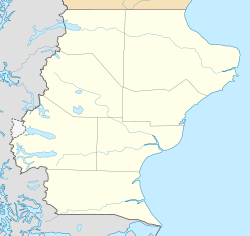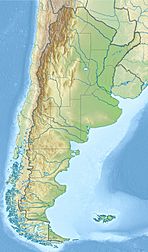Laguna del Carbón facts for kids
Quick facts for kids Laguna del Carbón |
|
|---|---|
 |
|
| Location | Corpen Aike Department, Santa Cruz Province, Argentina |
| Coordinates | 49°34′34″S 68°21′05″W / 49.5762°S 68.3514°W |
| Lake type | Endorheic salt lake |
| Primary outflows | Terminal (evaporation) |
| Basin countries | Argentina |
| Max. length | 5 km (3.1 mi) |
| Max. width | 2 km (1.2 mi) |
| Surface area | 9 km2 (3.5 sq mi) |
| Surface elevation | −105 m (−344 ft) |
Laguna del Carbón (which means "coal lagoon" in Spanish) is a very special salt lake in Argentina. It is located in Corpen Aike Department, within Santa Cruz Province. This lake is famous because it is the lowest point in all of Argentina and even the entire Americas! It is also the seventh-lowest point on Earth.
Discovering Laguna del Carbón
Laguna del Carbón is found in the Corpen Aike Department of Santa Cruz Province, Argentina. It is about 54 kilometers (34 miles) away from the town of Puerto San Julián. The lake sits inside a large, low area called the Gran Bajo de San Julián, which means the "Great San Julián Depression."
Why is this lake so low?
This lake is part of an endorheic basin. This means it is a closed area where water flows in but does not flow out to the ocean or any other body of water. Instead, the water in Laguna del Carbón can only leave by evaporating into the air. Over a very long time, this process has caused the land to sink, creating a deep depression.
At 105 meters (about 344 feet) below sea level, Laguna del Carbón holds the record as the lowest point in both Argentina and the Americas. It is also one of the seven lowest points on Earth. This makes it a truly unique geographical feature!
What about dinosaurs?
Just like in many other places across Patagonia, the region where Laguna del Carbón is located, scientists have found dinosaur fossils in the area. These fossils give us clues about the ancient creatures that once roamed this land millions of years ago. It shows that this part of Argentina has a rich history, not just for its unique landscape, but also for its prehistoric life!
See also
 In Spanish: Laguna del Carbón (Santa Cruz) para niños
In Spanish: Laguna del Carbón (Santa Cruz) para niños



